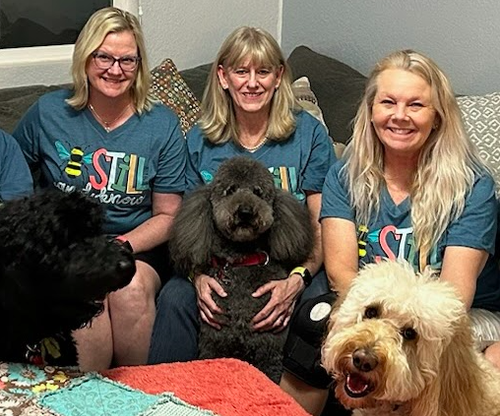How to Make a Child Feel like They Belong
This blog covers:
Why Belonging Is Important
Kids Belonging
How to Make a Child Feel like They Belong
Children Finding Connection
Know When You Need to Get Support as the Caregiver
Never Doubt God's Power to Work in You
Why Belonging Is Important:
We Want Kids to Belong and Feel like They Belong for Their Physical and Mental Health
According to Angela Theisen, L.C.S.W. with Mayo Clinic, "We cannot separate the importance of a sense of belonging from our physical and mental health. The social ties that accompany a sense of belonging are a protective factor helping manage stress and other behavioral issues. When we feel we have support and are not alone, we are more resilient, often coping more effectively with difficult times in our lives. Coping well with hardships decreases the physical and mental effects of these situations."
Children Finding Connection
As kids have come into our home, finding a connection is one of the first things they seek after looking around to see if our house feels safe. They often will reflect your nervous system. If they feel safe, they will be able to begin connecting. Kids new to our home often reach out to touch the cat, the dog, or the baby. They are reaching for comfort and belonging. Children find a connection where it is easiest to access.
A child cannot relax and feel safe if you feel anxious as the caregiver. Children can feel it and subconsciously follow you if you are worried or fearful. Learn to take slow deep breaths and relax your body. If you don't know how to calm your body, practice, and research ways such as putting your hand on your chest and telling yourself, "I'm okay."
Kids Belonging
When our oldest daughter moved in as a foster child, she loved playing with our baby son on the floor. When big emotions overtook her as she rode the waves of grief of the loss of her family, she often reached for him. He was a safe person to touch or snuggle. As the mom in the house, I represented the subconscious connections to her tumultuous feelings toward her mom.
Many times foster children were not allowed to express anger or frustration with their birth parent, and when kids were removed from their birth parent or parents, they suppressed many of these big feelings. Unfortunately, a foster mom often becomes the target of these powerful emotions when a child feels safe with you, or sometimes beforehand, when they aren't attached to you.
How to Make a Child Feel like They Belong
There are things we can do to support attachment and help kids belong.
Take time for natural expressions of touch, such as helping a younger child put lotion on their arm and legs, giving them a piggyback ride, play tag, braiding or brushing hair, or reading to a child beside you on the couch. Give a foot, hand, or back rub. Help a teen with make-up or arm wrestle for fun. Give a hug or a pat on the arm or back. Play games and go on little adventures together.
There are simple actions you can take at home to help kids' brains make connections that will ready them for belonging. Some things you can do today include getting outside more. Provide opportunities for large motor movements like jumping, climbing, swimming, walking, and running. You can do these activities as a family or by allowing your child to join organized sports.
Supplemental support can make a huge difference too. For example, vitamin D and melatonin help regulate energy levels and increase everyone's ability to sleep. Sleep is pivotal in regulating functions, including mood. In our home, these supplements significantly decreased temper tantrums for a couple of our kids because they slept better.
Make sleep a priority. How Much Sleep Do Kids Need?
Kidshealth.org says, While every child is different, experts recommend:
- infants (0–3 months): 14–17 hours, including naps
- infants (4–12 months: 12–16 hours, including naps
- toddlers (1–2 years): 11–14 hours, including naps
- preschool (3–5 years): 10–13 hours, including naps
- school-age (6–13 years): 9–12 hours
- teens (14–17 years): 8–10 hours
There are things we can do as adults to keep things away from our children that hinder attachment and belonging.
Reducing sugar and artificial flavors and colors - especially RED 40! Usually, the last ingredient in most red, pink, or orange-colored foods, such as candy, jello, strawberry milk, ketchup, etc. After 19 years of teaching, I could tell when there was "pink milk" at breakfast before the kids even made it into my classroom. It is like SPEED to some kids (usually those prone to be very active).
Limit screen time.
Know When You Need to Get Support as the Caregiver
An attachment connection is possible. However, sometimes you need a lot more than love and counseling.
I ignorantly thought that loving a child and treating them like my birth children would communicate belonging to foster children. Conversations with other foster mom's over the years echo my thoughts, "We treated (him/her/them) like our own children." Yet, somehow they still ended up rejecting our family or me.
The truth is that they came from another family. Their basic needs for food, shelter, safety, and love were met or not met in their first family, and the way they were trained to get their needs met changed how their brains functioned.
As a parent, sometimes you need help with children who have suffered severe trauma or have attachment disorders. Having fostered 42 children, I came to understand how caring for a child with attachment issues can break a parent down emotionally and physically. So I went to play therapy with some of our children and found it helpful since many could not process and verbalize their experiences.
A Publication of the American Counseling Association, Counseling Today states,
When young children, ages 2 to 9, are experiencing emotional and behavioral problems, the usefulness of talk therapy is limited because they often cannot communicate effectively using words. Play therapy continues to gain momentum as children communicate best through their usual way of relating — play.
As described by Landreth in the third edition of his book Play Therapy: The Art of the Relationship, child-centered play therapy adheres to the objectives of helping children become:
- More self-reliant
- More accepting of themselves
- Better problem solvers
- Better able to assume responsibility for their behaviors
It is crucial for the mental well-being of caregivers to feel safe with their children. One mom shared that she didn't feel safe as a mom. She found she couldn't have fun, relax, or "let go" because she often felt nervous and frightened. If you are struggling with calming your nervous system or don't feel safe with one of your children, get help. There are support services that can wrap around caregivers. Don't isolate yourself. There is help. Begin with talking to a counselor and finding resources and training for specific needs related to foster parents and children.
Never Doubt God's Power to Work in You
"By constantly using your faith, the life of Christ will be released deep inside you, and the resting place of his love will become the very source and root of your life. Then you will be empowered to discover what every holy one experiences—the great magnitude of the astonishing love of Christ in all its dimensions. How deeply intimate and far-reaching is his love! How enduring and inclusive it is! Endless love beyond measurement that transcends our understanding—this extravagant love pours into you until you are filled to overflowing with the fullness of God! Never doubt God's mighty power to work in you and accomplish all this. He will achieve infinitely more than your greatest request, your most unbelievable dream, and exceed your wildest imagination!" Eph. 3:17-20a
Never doubt God's power to work in and through you as you love and interact with vulnerable kids.
Conclusion
We Want Kids to Belong and Feel like They Belong for Their Physical and Mental Health
How to Make a Child Feel like They Belong
Children Finding Connection
There Are Things We Can Do to Support Attachment and Help Kids Belong
Know When You Need to Get Support as the Caregiver
Never Doubt God's Power to Work in You
You can do hard things. So let me encourage you along the way.
What questions or topics would you like me to cover about foster care? Please comment below. If you would like to receive my blog when it comes out, please sign up
Robin LaVonne Hunt and her husband have fostered 42 children and adopted one of their four children. She wrote the book Breathing through Foster Care: A Survival Guide Based on the Reflection of a Foster Mom to encourage parents and those interested in understanding vulnerable children. Some of Robin’s passions include teaching, learning, reading, and writing. She loves to share her story and hear how God has worked through others’ life stories. You can contact her at bebravelovewell@gmail.com.
Resources:
https://kidshealth.org/en/parents/naps.html
https://ct.counseling.org/2014/08/involving-parents-in-child-centered-play-therapy/#:~:text=Through%20a%20supportive%20and%20caring,to%20control%20their%20own%20behaviors




